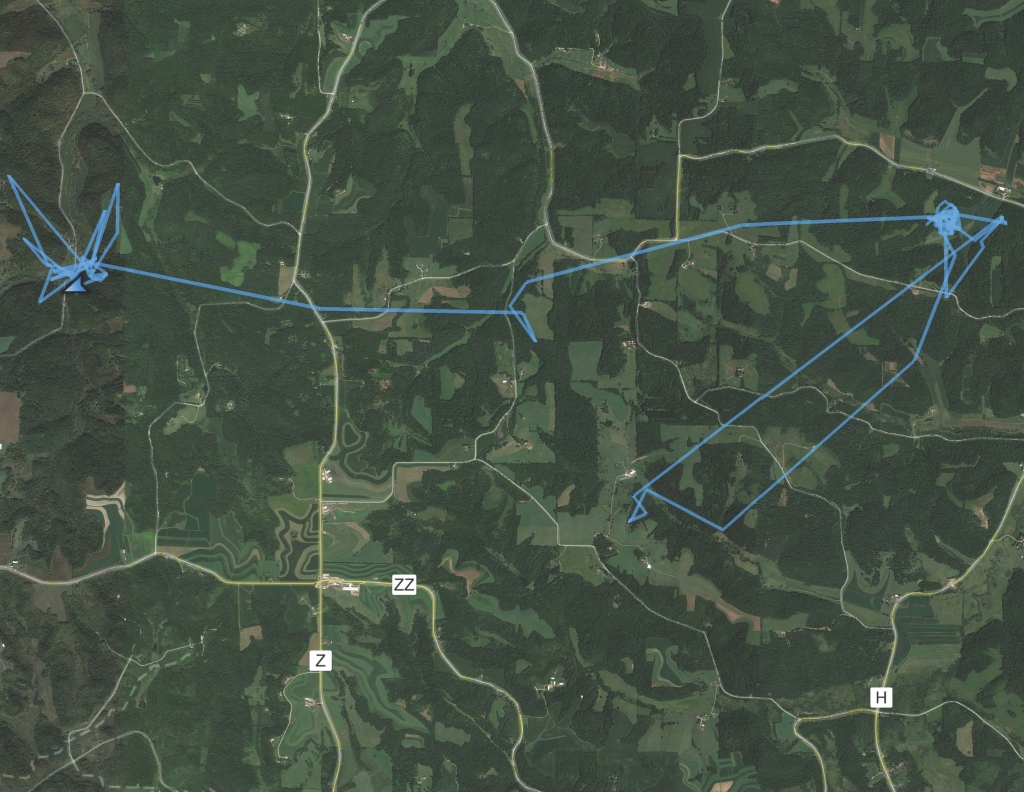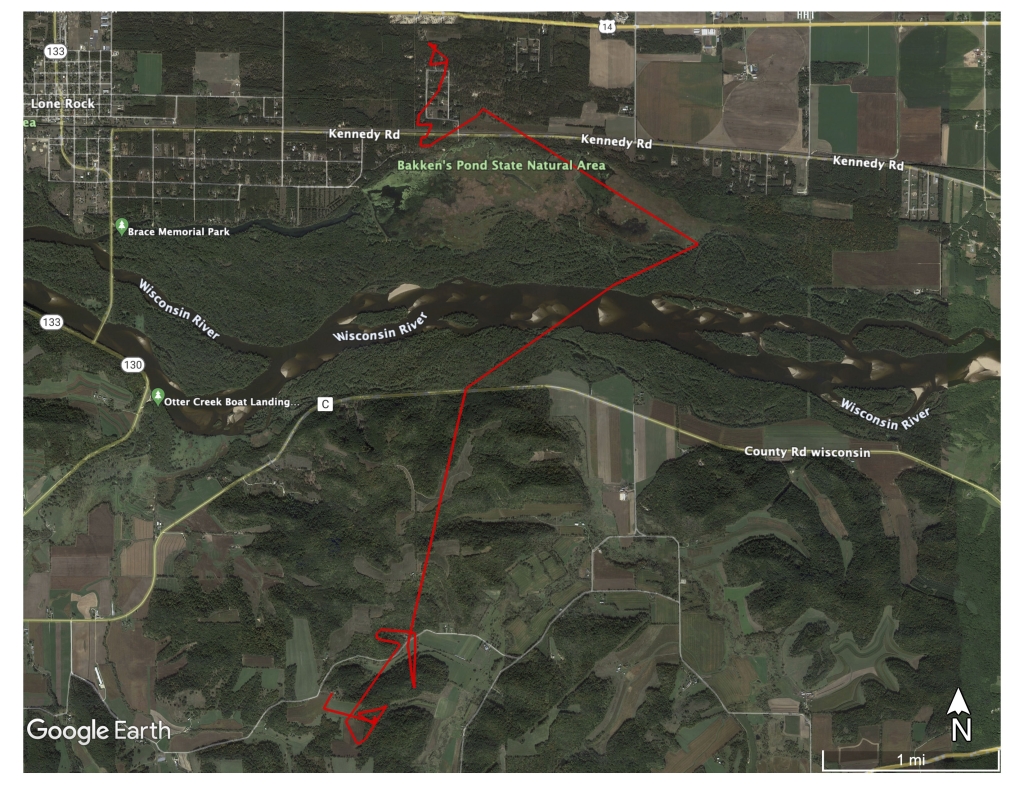November 2022 - Field Notes Newsletter
The research team has another analysis ready to share. Dr. Marie Gilbertson has been analyzing GPS location data to follow juvenile white-tailed deer as they venture from their birth range to establish home ranges of their own. She dives into the who, when, where and why to further our understanding of how Wisconsin’s deer population uses the landscape and how dispersal may contribute to the spread of CWD. Some of the deer made some impressive journeys, and Gilbertson shares a few animated maps of the deer’s paths as examples.
The juvenile dispersal results described below have also been peer-reviewed by an independent group of science experts and are published in the Journal of Movement Ecology. Read on for more details.
Learning More About Juvenile Dispersal
Around the time juvenile deer reach their first birthday, many are driven from their natal range by their mother. This aggressive behavior helps make room in the doe’s territory for her to give birth again this year. But what happens to the juvenile once it's forced to disperse and find a new home?
For young deer, moving territories can be a dangerous time. They need to travel to unknown areas, find an area that isn’t claimed by other deer and make sure there is enough food to keep them fed all year. It’s no easy feat to strike out on one’s own for the first time.
This big milestone is important in another way though because dispersing deer could carry CWD to an area that previously didn’t have the disease. In this way, dispersal can shape how CWD moves around the landscape.
To understand how juvenile dispersal impacts CWD spread, our research team broke the problem into some basic questions:
- Who is dispersing?
- When are they dispersing?
- Where are they dispersing?
Our team also asked some deeper questions about what drives dispersal:
- Why do deer disperse?
- What paths do they take when they travel?
These last two questions are especially helpful for understanding how things like land use shape deer dispersal patterns. Dr. Marie Gilbertson, a Research Scientist with the Wisconsin Cooperative Wildlife Research Unit at the University of Wisconsin-Madison, has been leading the charge to find answers to these questions. Some may recognize her as the researcher who analyzed the necropsy data (discussed in the previous newsletter). Gilbertson is back to help us understand more about deer - this time, we’re learning about deer dispersal.
To get everyone in the mindset of deer dispersal, Gilbertson put together the following short gif, showing a dispersal event through time.
Location data is transmitted by the deer's collar every couple of hours, so the line moves from one data point straight to the next. From the gif, some of the deer's patterns can be observed, such as moving quickly through fields and lingering in forests. Gilbertson discusses those patterns and more next.
Dispersal: Who, When And Where?
Before we dive into who was dispersing, let’s first clarify what dispersal means.
Dispersal occurs when an individual shifts their home range to a new, non-overlapping territory. This shift in home ranges is permanent, distinguishing it from temporary and other types of movement where the individual returns to their original home range after a while.
In our study, dispersal was most common amongst a single age-sex combination, juvenile bucks. Juvenile bucks refer to bucks born the prior year and are experiencing their first opportunity to strike out on their own. 64% of juvenile bucks dispersed in our study.
Other age-sex combinations, such as juvenile does and adults of both sexes, also included dispersers but at a much lower rate. The rate of dispersal was 2-13% for all other groups, much lower than juvenile bucks. These results show that juvenile bucks are responsible for a lot of the dispersal events happening in southwestern Wisconsin, but it doesn’t necessarily mean that juvenile males are the only group of deer that matter here (as we’ll discuss later).
Studies of deer dispersal in other regions of North America have, in some cases, found much higher rates of dispersal for females than Gilbertson and her colleagues saw. “We don’t know why there was such a difference in female dispersal rates between our study and some other research studies. We know that male and female deer likely have different reasons for dispersing — females seem to prioritize access to resources and habitats like good forest cover for raising their young, while males seem to disperse because either their mom kicks them out or because they’re trying to gain access to mates.”
Gilbertson said these different potential motivators were apparent to her when evaluating the data. Gilbertson found that females dispersed only in the spring (especially February through May), which aligns with the hypothesis that spring dispersal is driven by access to resources. In contrast, males dispersed in both the spring (March through June) and fall (August through November). Those spring dispersals likely represent dispersals driven by a young buck’s mother pushing him out of his natal range, while the fall dispersals are most likely bucks shifting to new areas to gain access to mates as the rut approaches.
When Gilbertson next evaluated where dispersing individuals went, she found that deer in the study typically dispersed short distances: the average dispersal distance was only 3.6 mi (5.77 km). However, dispersal distances — much like dispersal timings — were different between males and females, as well as between spring and fall.
The average dispersal distance for females was 3.1 mi (5.1km). Yet, for males, dispersal distance differed depending on the time of year. Their spring dispersal averaged 7.2 mi (11.6km), while their average fall dispersal was similar to the female spring dispersal distance. Gilbertson suspects the difference between spring and fall dispersal distances for males likely again represents their different motivations for dispersing. “Other studies have seen that same pattern, where males go shorter distances in the fall. The thinking is that the distance males need to go in the fall to improve their access to mates isn’t very long in contrast to spring dispersals when mom has kicked them out, and they need to find a new range,” said Gilbertson.
In the image above, we can see an example of a “typical” disperser. This young buck was born in the spring of 2016 with his natal range on the east (right) side of the image. In the spring of 2017, he made an exploratory movement to the southwest of his natal range, before eventually successfully dispersing to the west (left) in May 2017. We can see where he established his new range by the clustering of locations in the western area. The straight-line distance between his natal and new range was about 5.4 mi (8.7km), and the trip took him about 36 hours.
Overall, the research team was glad to see that deer were dispersing relatively short distances. However, there were some notable exceptions. A total of five long-distance dispersals were observed by Gilbertson and the research team. Each exception traveled over twice the average distance, and one female in particular dispersed over 42 mi (68km) in 11 days. That’s about 13 times the average distance between females. This doe went the farthest of all dispersers.
Fortunately, long-distance dispersals don’t seem to happen often in the study area, but the research team is interested in these rare events because of their potential impact on CWD spread. Long-distance dispersals, while rare, could spread CWD to new areas of the state.
Why Are Deer Dispersing?
While the answers to who, when and where deer are dispersing gave clues about deer’s motivations for dispersal, Gilbertson and her colleagues knew this wasn’t the whole picture. To get a better idea of how an individual’s surroundings affect dispersal, Gilbertson also tested how the land type (forested, developed or agricultural) changed whether deer disperse and how far they traveled.
Gilbertson said the collar data revealed an interesting relationship between agricultural land and juvenile dispersal. In the spring, the more agricultural land (e.g. land used for crops or pasture/hay) in a juvenile buck’s natal range, the more likely he was to disperse. Additionally, these males tended to disperse longer distances if the area around their natal range had more agricultural land. The flip side was also true; in the spring, juvenile bucks were less likely to disperse with more forest cover in their natal range, and, regardless of season, they dispersed shorter distances if there was more forest cover in their potential dispersal pathways.
“We looked at a bunch of other potential drivers for deer dispersal like deer body weight or how easy it might be to travel through the landscape,” said Gilbertson. However, none of them were significant drivers of dispersal, according to the statistics. “By far, the most important driver was the consistent role of agricultural lands in increasing the probability of dispersal and increasing dispersal distances.”
What Paths Do Dispersing Deer Take?
Understanding how dispersal might affect the spread of diseases like CWD means knowing not just how far deer go, but also in which directions and habitat types deer disperse. For example, if deer tend to disperse along rivers or streams (meaning deer travel along rivers instead of crossing them), then we might expect CWD to spread to new areas along those waterways.
Gilbertson used a type of analysis called step-selection analysis. “You just compare what the habitat is like at the steps that a collared deer took against the steps they could have taken,” explained Gilbertson. “If a dispersing deer frequently took steps near rivers or streams when they had lots of available steps further away from these waterways, we’d conclude that they select for being close to rivers and streams when dispersing. We can likewise look at things like landcover — do deer seem to preferentially step in agricultural land or forested cover?”
In the animation above, we see the dispersal path of a juvenile buck in southwest Wisconsin. He was born in 2017 and dispersed the following year. In this animation, the forested cover is shown in green, agricultural land use in yellow and major roads in brown. We can see he starts in his natal range in the forested region to the north. When he begins dispersing, he quickly encounters Highway 18 and gets stuck at it for a while. Eventually, he crosses the road and disperses through a heavily agricultural area to the south. Note how this individual moves quickly through agricultural land while dispersing, preferring to stay in forested patches. In total, this dispersal event took five days and covered 16.8 mi (27km) as the crow flies. This deer outlived his collar battery, so his CWD status is unknown.
Using this analysis, Gilbertson found that juvenile bucks tended to avoid steps in agricultural lands during their dispersal events. This avoidance pattern means that dispersing juveniles quickly traveled through agricultural land, moving from forested cover to forested cover.
“It was interesting to see that these dispersing deer avoided agricultural land types,” said Gilbertson, “but it does make sense if you think about what it’s like to be a young, dispersing deer. In the spring, before the crops or grasses have grown up, agricultural land wouldn’t provide great cover for dispersing deer. Dispersal is risky. If you’re a young deer dispersing through an unfamiliar area, it makes sense that you’d prefer what you perceive to be the safest landscapes [like forests].”
Gilbertson also looked into whether certain types of obstacles acted as barriers to dispersal, such as rivers and roads. “If you look at a map of our study area, you can see the Wisconsin river in the northern part of the map, as well as Highway 18 just south of the study area. You don’t see deer moving north across the river frequently, and you don’t see many going south across the highway either. The river [north] and highway [south] shaped where our dispersers moved,” Gilbertson said.
“Knowing what counts as barriers helps us predict where the disease is likely to spread across the state,” continued Gilbertson. “Rivers, major roads and spans of agricultural land all may influence the spread of CWD through directing deer movements in certain directions, increasing the potential for spread in those directions.”
A Rare And Remarkable River Crossing
Even though deer tended to avoid crossing the river and major roads, it does happen sometimes. There was one exception that stood out to Gilbertson as a curiosity/oddity. This example isn’t representative of the other deer in the study, but it still reminds us that barriers aren’t impenetrable and can be crossed in the right circumstances.
One of the collared deer that Gilbertson studied crossed the Wisconsin River. This individual was an 11-year-old female who we estimate was born in 2007. In May 2018, she took about eight hours to cross the river and find a new home, and she died in this new range a few months later. What makes this individual stand out is that she was an older female, and individuals of this age and sex class rarely shifted to new ranges in our study. Not only that, but she also must have swam across the river, which is no easy feat. A map of her movements is below.
In the image above, we see the path of an 11-year-old female white-tailed deer in southwest Wisconsin. This individual’s original home range was on the south side of the river (at the bottom of the image), but she permanently crossed the major Wisconsin river and established a new range in the north. Adult range shifts like this were rare, and this female was the only one in the study to shift ranges across the Wisconsin River.
How Do These Results Change How We Think About CWD?
Gilbertson said the biggest takeaway for her was the importance of agricultural land cover in influencing deer dispersal. “We saw that land use is important to how frequently and far deer are dispersing. Land use even impacts the paths deer choose to take when they do disperse. When it comes to CWD, that could be important to understanding where CWD could go next. For example, one might expect more geographical spread [of CWD] in agricultural areas than in forested ones. That difference may impact how CWD surveillance and management are set up in the future,” said Gilbertson. CWD surveillance and management zones should take land use into account when predicting the risk of CWD spread to new areas.
Fortunately, there is good news. Because typical dispersals traveled relatively short distances and stayed within the study area, most dispersal events shouldn’t bring CWD into totally new areas. Furthermore, juvenile deer were responsible for most dispersal events, and they tend to have a lower chance of having CWD than adults do. That means the “riskiest” dispersal events — long-distance range shifts by adult deer — are unlikely to occur.
However, we can't completely write off dispersal's impact on CWD spread, since we've seen CWD cases among deer less than a year of age.
Peer-Reviewed Results
After Gilbertson finished analyzing the data and thinking about her results, she submitted a scholarly publication for review/vetting by the scientific community. The research team is happy to announce that the publication was recently accepted, marking a major milestone for the project - our first publication. Congratulations to Gilbertson and co-authors.
Publications are how the science world shares its findings and ensure integrity. Peer review is a long process that can take 3-18 months to complete, so expect a delay between when future results are reported in this newsletter and when the publication is officially accepted and available.
If you’d like to learn more about the methods used in Gilbertson’s study of juvenile dispersal or the full explanation of results, check out the publication at the link in the citation below.
Gilbertson, M.L.J., Ketz, A.C., Hunsaker, M. et al. (2022). Agricultural land use shapes dispersal in white-tailed deer (Odocoileus virginianus). Mov Ecol 10, 43. https://doi.org/10.1186/s40462-022-00342-5 [exit DNR]
Gilbertson and co-authors’ publication is just the first of many to come. We will continue to announce new publications in future Field Notes newsletters! All scientific publications published by DNR research scientists are archived on our Publications and Reports webpage.
Next Steps
While the rest of the research team continues to work on the Integrated Population Model (see the May 2021 newsletter for more information), Gilbertson will continue to learn what she can from the GPS location data.
Gilbertson said she is still investigating research questions related to deer movements and their impact on CWD. For example, she’s pursuing how the social dynamics of deer shape deer movement and CWD transmission. She's looking into questions, including:
- Where and when do deer interact with each other?
- How do these interactions change seasonally?
- Do they differ, depending on the age or sex of the deer?
- Does CWD status change how deer interact with one another?
Through researching these questions, Gilbertson will continue to dig into how deer movement and behavior impact the spread of CWD within the deer population. More to come in future newsletters!







